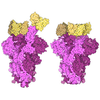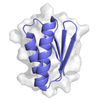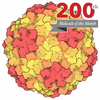[English] 日本語
 Yorodumi
Yorodumi- PDB-9ds1: Crystal structure of 241_2F04 Fab in complex with H1 HA from A/Ca... -
+ Open data
Open data
- Basic information
Basic information
| Entry | Database: PDB / ID: 9ds1 | ||||||
|---|---|---|---|---|---|---|---|
| Title | Crystal structure of 241_2F04 Fab in complex with H1 HA from A/California/04/2009(H1N1) | ||||||
 Components Components |
| ||||||
 Keywords Keywords | VIRAL PROTEIN/IMMUNE SYSTEM / H1N1 / Antibody / Hemagglutinin / VIRAL PROTEIN-IMMUNE SYSTEM complex / VIRAL PROTEIN | ||||||
| Function / homology |  Function and homology information Function and homology informationviral budding from plasma membrane / clathrin-dependent endocytosis of virus by host cell / host cell surface receptor binding / fusion of virus membrane with host plasma membrane / fusion of virus membrane with host endosome membrane / viral envelope / virion attachment to host cell / host cell plasma membrane / virion membrane / membrane Similarity search - Function | ||||||
| Biological species |   Influenza A virus Influenza A virus Homo sapiens (human) Homo sapiens (human) | ||||||
| Method |  X-RAY DIFFRACTION / X-RAY DIFFRACTION /  SYNCHROTRON / SYNCHROTRON /  MOLECULAR REPLACEMENT / Resolution: 2.4 Å MOLECULAR REPLACEMENT / Resolution: 2.4 Å | ||||||
 Authors Authors | Lin, T.H. / Wilson, I.A. | ||||||
| Funding support |  United States, 1items United States, 1items
| ||||||
 Citation Citation |  Journal: Nat Commun / Year: 2025 Journal: Nat Commun / Year: 2025Title: Structurally convergent antibodies derived from different vaccine strategies target the influenza virus HA anchor epitope with a subset of V3 and V3 genes. Authors: Ting-Hui Lin / Chang-Chun David Lee / Monica L Fernández-Quintero / James A Ferguson / Julianna Han / Xueyong Zhu / Wenli Yu / Jenna J Guthmiller / Florian Krammer / Patrick C Wilson / ...Authors: Ting-Hui Lin / Chang-Chun David Lee / Monica L Fernández-Quintero / James A Ferguson / Julianna Han / Xueyong Zhu / Wenli Yu / Jenna J Guthmiller / Florian Krammer / Patrick C Wilson / Andrew B Ward / Ian A Wilson /   Abstract: H1N1 influenza viruses are responsible for both seasonal and pandemic influenza. The continual antigenic shift and drift of these viruses highlight the urgent need for a universal influenza vaccine ...H1N1 influenza viruses are responsible for both seasonal and pandemic influenza. The continual antigenic shift and drift of these viruses highlight the urgent need for a universal influenza vaccine to elicit broadly neutralizing antibodies (bnAbs). Identification and characterization of bnAbs elicited in natural infection and immunization to influenza virus hemagglutinin (HA) can provide insights for development of a universal influenza vaccine. Here, we structurally and biophysically characterize four antibodies that bind to a conserved region on the HA membrane-proximal region known as the anchor epitope. Despite some diversity in their V and V genes, the antibodies interact with the HA through germline-encoded residues in HCDR2 and LCDR3. Somatic mutations on HCDR3 also contribute hydrophobic interactions with the conserved HA epitope. This convergent binding mode provides extensive neutralization breadth against H1N1 viruses and suggests possible countermeasures against H1N1 viruses. | ||||||
| History |
|
- Structure visualization
Structure visualization
| Structure viewer | Molecule:  Molmil Molmil Jmol/JSmol Jmol/JSmol |
|---|
- Downloads & links
Downloads & links
- Download
Download
| PDBx/mmCIF format |  9ds1.cif.gz 9ds1.cif.gz | 202.6 KB | Display |  PDBx/mmCIF format PDBx/mmCIF format |
|---|---|---|---|---|
| PDB format |  pdb9ds1.ent.gz pdb9ds1.ent.gz | 157.4 KB | Display |  PDB format PDB format |
| PDBx/mmJSON format |  9ds1.json.gz 9ds1.json.gz | Tree view |  PDBx/mmJSON format PDBx/mmJSON format | |
| Others |  Other downloads Other downloads |
-Validation report
| Summary document |  9ds1_validation.pdf.gz 9ds1_validation.pdf.gz | 800.7 KB | Display |  wwPDB validaton report wwPDB validaton report |
|---|---|---|---|---|
| Full document |  9ds1_full_validation.pdf.gz 9ds1_full_validation.pdf.gz | 809.9 KB | Display | |
| Data in XML |  9ds1_validation.xml.gz 9ds1_validation.xml.gz | 39.8 KB | Display | |
| Data in CIF |  9ds1_validation.cif.gz 9ds1_validation.cif.gz | 52.3 KB | Display | |
| Arichive directory |  https://data.pdbj.org/pub/pdb/validation_reports/ds/9ds1 https://data.pdbj.org/pub/pdb/validation_reports/ds/9ds1 ftp://data.pdbj.org/pub/pdb/validation_reports/ds/9ds1 ftp://data.pdbj.org/pub/pdb/validation_reports/ds/9ds1 | HTTPS FTP |
-Related structure data
| Related structure data | 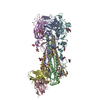 9dm0C  9druC  9ds2C  9dscC C: citing same article ( |
|---|---|
| Similar structure data | Similarity search - Function & homology  F&H Search F&H Search |
- Links
Links
- Assembly
Assembly
| Deposited unit | 
| |||||||||
|---|---|---|---|---|---|---|---|---|---|---|
| 1 | 
| |||||||||
| Unit cell |
| |||||||||
| Components on special symmetry positions |
|
- Components
Components
-Hemagglutinin ... , 2 types, 2 molecules AB
| #1: Protein | Mass: 36213.812 Da / Num. of mol.: 1 Source method: isolated from a genetically manipulated source Source: (gene. exp.)   Influenza A virus / Gene: HA / Production host: Influenza A virus / Gene: HA / Production host:  Trichoplusia ni (cabbage looper) / References: UniProt: A0A5B9ZSV0 Trichoplusia ni (cabbage looper) / References: UniProt: A0A5B9ZSV0 |
|---|---|
| #2: Protein | Mass: 19992.076 Da / Num. of mol.: 1 Source method: isolated from a genetically manipulated source Source: (gene. exp.)   Influenza A virus / Gene: HA / Production host: Influenza A virus / Gene: HA / Production host:  Trichoplusia ni (cabbage looper) / References: UniProt: A0A6J3XB93 Trichoplusia ni (cabbage looper) / References: UniProt: A0A6J3XB93 |
-Antibody , 2 types, 2 molecules HL
| #3: Antibody | Mass: 24169.281 Da / Num. of mol.: 1 Source method: isolated from a genetically manipulated source Source: (gene. exp.)  Homo sapiens (human) / Production host: Homo sapiens (human) / Production host:  |
|---|---|
| #4: Antibody | Mass: 23493.066 Da / Num. of mol.: 1 Source method: isolated from a genetically manipulated source Source: (gene. exp.)  Homo sapiens (human) / Production host: Homo sapiens (human) / Production host:  |
-Sugars , 2 types, 2 molecules 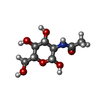
| #5: Polysaccharide | beta-D-mannopyranose-(1-4)-2-acetamido-2-deoxy-beta-D-glucopyranose-(1-4)-2-acetamido-2-deoxy-beta- ...beta-D-mannopyranose-(1-4)-2-acetamido-2-deoxy-beta-D-glucopyranose-(1-4)-2-acetamido-2-deoxy-beta-D-glucopyranose Source method: isolated from a genetically manipulated source |
|---|---|
| #6: Sugar | ChemComp-NAG / |
-Non-polymers , 1 types, 129 molecules 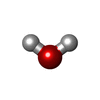
| #7: Water | ChemComp-HOH / |
|---|
-Details
| Has ligand of interest | Y |
|---|---|
| Has protein modification | Y |
-Experimental details
-Experiment
| Experiment | Method:  X-RAY DIFFRACTION / Number of used crystals: 1 X-RAY DIFFRACTION / Number of used crystals: 1 |
|---|
- Sample preparation
Sample preparation
| Crystal | Density Matthews: 3.45 Å3/Da / Density % sol: 64.3 % |
|---|---|
| Crystal grow | Temperature: 293 K / Method: vapor diffusion, hanging drop / Details: 0.2 M sodium acetate, pH 6.4, 16% PEG3350 |
-Data collection
| Diffraction | Mean temperature: 100 K / Serial crystal experiment: N |
|---|---|
| Diffraction source | Source:  SYNCHROTRON / Site: SYNCHROTRON / Site:  SSRL SSRL  / Beamline: BL12-1 / Wavelength: 0.97934 Å / Beamline: BL12-1 / Wavelength: 0.97934 Å |
| Detector | Type: DECTRIS EIGER X 16M / Detector: PIXEL / Date: Nov 16, 2021 |
| Radiation | Protocol: SINGLE WAVELENGTH / Monochromatic (M) / Laue (L): M / Scattering type: x-ray |
| Radiation wavelength | Wavelength: 0.97934 Å / Relative weight: 1 |
| Reflection | Resolution: 2.4→39.43 Å / Num. obs: 54268 / % possible obs: 96 % / Redundancy: 19 % / CC1/2: 1 / Rmerge(I) obs: 0.18 / Rpim(I) all: 0.04 / Net I/σ(I): 15 |
| Reflection shell | Resolution: 2.4→2.44 Å / Rmerge(I) obs: 1.1 / Num. unique obs: 54123 / CC1/2: 0.9 / Rpim(I) all: 0.28 |
- Processing
Processing
| Software |
| |||||||||||||||||||||||||||||||||||||||||||||||||||||||||||||||||||||||||||||||||||||||||||||||||||||||||||||||||||||||||||||||||||||||||||||||||||
|---|---|---|---|---|---|---|---|---|---|---|---|---|---|---|---|---|---|---|---|---|---|---|---|---|---|---|---|---|---|---|---|---|---|---|---|---|---|---|---|---|---|---|---|---|---|---|---|---|---|---|---|---|---|---|---|---|---|---|---|---|---|---|---|---|---|---|---|---|---|---|---|---|---|---|---|---|---|---|---|---|---|---|---|---|---|---|---|---|---|---|---|---|---|---|---|---|---|---|---|---|---|---|---|---|---|---|---|---|---|---|---|---|---|---|---|---|---|---|---|---|---|---|---|---|---|---|---|---|---|---|---|---|---|---|---|---|---|---|---|---|---|---|---|---|---|---|---|---|
| Refinement | Method to determine structure:  MOLECULAR REPLACEMENT / Resolution: 2.4→39.43 Å / SU ML: 0.36 / Cross valid method: FREE R-VALUE / σ(F): 1.36 / Phase error: 31.37 / Stereochemistry target values: ML MOLECULAR REPLACEMENT / Resolution: 2.4→39.43 Å / SU ML: 0.36 / Cross valid method: FREE R-VALUE / σ(F): 1.36 / Phase error: 31.37 / Stereochemistry target values: ML
| |||||||||||||||||||||||||||||||||||||||||||||||||||||||||||||||||||||||||||||||||||||||||||||||||||||||||||||||||||||||||||||||||||||||||||||||||||
| Solvent computation | Shrinkage radii: 0.9 Å / VDW probe radii: 1.1 Å / Solvent model: FLAT BULK SOLVENT MODEL | |||||||||||||||||||||||||||||||||||||||||||||||||||||||||||||||||||||||||||||||||||||||||||||||||||||||||||||||||||||||||||||||||||||||||||||||||||
| Refinement step | Cycle: LAST / Resolution: 2.4→39.43 Å
| |||||||||||||||||||||||||||||||||||||||||||||||||||||||||||||||||||||||||||||||||||||||||||||||||||||||||||||||||||||||||||||||||||||||||||||||||||
| Refine LS restraints |
| |||||||||||||||||||||||||||||||||||||||||||||||||||||||||||||||||||||||||||||||||||||||||||||||||||||||||||||||||||||||||||||||||||||||||||||||||||
| LS refinement shell |
|
 Movie
Movie Controller
Controller



 PDBj
PDBj
